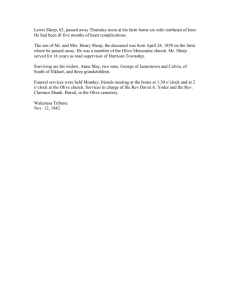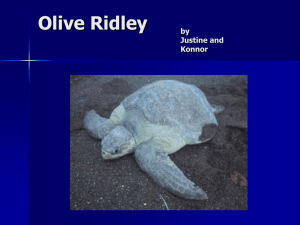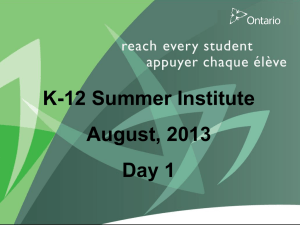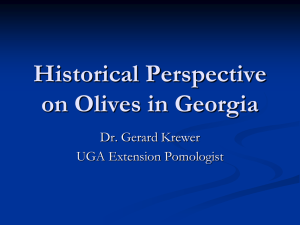Newsletter - Department of Entomology
advertisement
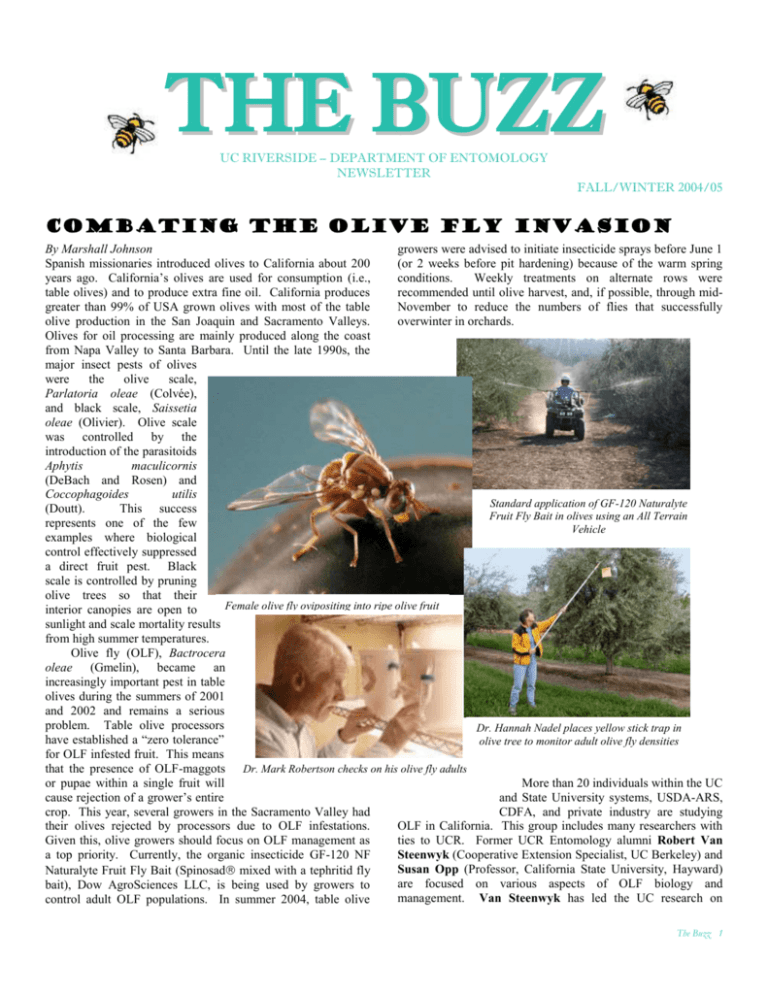
THE BUZZ UC RIVERSIDE – DEPARTMENT OF ENTOMOLOGY NEWSLETTER FALL/WINTER 2004/05 Combating the Olive Fly Invasion By Marshall Johnson growers were advised to initiate insecticide sprays before June 1 Spanish missionaries introduced olives to California about 200 (or 2 weeks before pit hardening) because of the warm spring years ago. California’s olives are used for consumption (i.e., conditions. Weekly treatments on alternate rows were table olives) and to produce extra fine oil. California produces recommended until olive harvest, and, if possible, through midgreater than 99% of USA grown olives with most of the table November to reduce the numbers of flies that successfully olive production in the San Joaquin and Sacramento Valleys. overwinter in orchards. Olives for oil processing are mainly produced along the coast from Napa Valley to Santa Barbara. Until the late 1990s, the major insect pests of olives were the olive scale, Parlatoria oleae (Colvée), and black scale, Saissetia oleae (Olivier). Olive scale was controlled by the introduction of the parasitoids Aphytis maculicornis (DeBach and Rosen) and Coccophagoides utilis Standard application of GF-120 Naturalyte (Doutt). This success Fruit Fly Bait in olives using an All Terrain represents one of the few Vehicle examples where biological control effectively suppressed a direct fruit pest. Black scale is controlled by pruning olive trees so that their Female olive fly ovipositing into ripe olive fruit interior canopies are open to sunlight and scale mortality results from high summer temperatures. Olive fly (OLF), Bactrocera oleae (Gmelin), became an increasingly important pest in table olives during the summers of 2001 and 2002 and remains a serious problem. Table olive processors Dr. Hannah Nadel places yellow stick trap in have established a “zero tolerance” olive tree to monitor adult olive fly densities for OLF infested fruit. This means that the presence of OLF-maggots Dr. Mark Robertson checks on his olive fly adults or pupae within a single fruit will More than 20 individuals within the UC cause rejection of a grower’s entire and State University systems, USDA-ARS, crop. This year, several growers in the Sacramento Valley had CDFA, and private industry are studying their olives rejected by processors due to OLF infestations. OLF in California. This group includes many researchers with Given this, olive growers should focus on OLF management as ties to UCR. Former UCR Entomology alumni Robert Van a top priority. Currently, the organic insecticide GF-120 NF Steenwyk (Cooperative Extension Specialist, UC Berkeley) and Susan Opp (Professor, California State University, Hayward) Naturalyte Fruit Fly Bait (Spinosad mixed with a tephritid fly are focused on various aspects of OLF biology and bait), Dow AgroSciences LLC, is being used by growers to management. Van Steenwyk has led the UC research on control adult OLF populations. In summer 2004, table olive The Buzz 1 insecticide baits and contributed data towards the registration of GF-120 Naturalyte Fruit Fly Bait. He is also refining the postharvest use of the plant growth regulator ethephon (Ethrel) to reduce olive fruit in commercial trees and urban areas so that OLF females cannot use the fruit for reproduction during the winter and spring. Opp has quantified the flight abilities of OLF adults using a computerized flight mill. In the laboratory, OLF adults commonly fly about 1.9 miles in 24 hours with maxium flight distance recorded as 6.5 miles by one male. Field studies on dispersal reveal that OLF adults often leave fruiting olive orchards and enter citrus and walnut plantings although they can only reproduce on olive fruit. It is uncertain why they display this behavior and answers are currently being sought. In my laboratory at the UC Kearney Agricultural Center in Parlier, UCR entomology alumnus Hannah Nadel is working on various lines of study including classical biological control (in collaboration with Kent Daane, Cooperative Extension Specialist, UC Berkeley), impacts of summer heat on OLF populations, and OLF seasonal phenology. On the UCR campus, Mark Robertson has improved upon an artificial diet developed in Greece for production of OLF. His modified diet allows us to produce OLF in drier conditions than Greece and at less expense. It may one day be the solution to implementing a sterile insect release program for OLF regional control in California. Robertson is also working on dispersal of OLF adults reared on artificial diet. Surveys that Nadel and I conducted over the last two summers in Tulare and Fresno Counties (San Joaquin Valley) indicate that adult OLF populations are low in untreated olive plantings during winter and mid to late summer. Based on yellow sticky trap catches, OLF densities appear to build up in spring and then dramatically decline when summer temperatures surpass 95°F. This decline in numbers recorded on sticky traps is partially due to a change in adult behavior (flies remain inactive and remain near water sources) when temperatures are high and to temperature-induced fly mortality. If an adult female does not have access to water or a carbohydrate source, she may die in less than 2 days at 95°F. Time to death decreases to 1 day at 100°F. However, if water and a carbohydrate source are available, a fly has an 80% chance of surviving 5 days at 105°F. This information has considerable importance given high temperature variation and variable access to water and food sources within the San Joaquin and Sacramento Valleys during the summer. Some growers may not need to treat for OLF during periods of high temperatures in some areas. Efforts are underway to use GIS methods to delineate areas in which OLF mortality will be high at certain times, and growers can depend on the heat to suppress the OLF. In the cooler coastal valleys and urban areas, classical biological control may provide greater and more predictable OLF control than summer heat. To date, eight braconid parasitoid species from various locations (e.g., South Africa, Hawaii, Pakistan) have been imported into the UC Berkeley Quarantine for analysis of their biology and host preference specificity. This project is a highly collaborative effort with investigators including Kent Daane (UC Berkeley), Kim Hoelmer (USDA-ARS), Russell Messing (University of Hawaii at Manoa), Charles Pickett (CDFA), Hannah Nadel and myself (UCR). To date, host specificity testing suggests that only two of the parasitoids pose a zero non-target risk if released for OLF suppression in California. These are Psyttalia lounsburyi and Utetes africanus. We hope to make initial releases of these parasitoids in spring 2005 following approval of our release requests. Marshall W. Johnson joined the department in April 2002. He is an Associate CE Specialist and Associate Entomologist. His office and laboratory are located at the UC Kearney Agricultural Center, Parlier, CA. His PhD is from UCR, and during his career he has held academic and research appointments at Kansas State University and the University of Hawaii at Manoa. HONORS AND AWARDS Beth Grafton-Cardwell received the Citrus Research Board’s Award of Excellence 2004 for exceptional service to the California citrus industry. Bob Krieger received the Society of Toxicology’s Public Communications Award. The official awards ceremony will be held on March 6, 2005 at the Society of Toxicology Annual Meeting in New Orleans. Dong-Hwan Choe’s picture submission to the National Wildlife Federation of a carpenter bee pollinating a native passion flower was one of the award winners in the magazine’s thirty-fourth annual photography competition. Dong-Hwan is a graduate student in Mike Rust’s lab. The Buzz 2 ALUMNUS FEATURE Lynn LeBeck (Ph.D., 1985) is the Academic Coordinator for the Center for Biological Control at UC-Berkeley. After 19 years away from California, she and her husband (Dr. Marshall Johnson, Ph.D. 1978), moved back in 2002. Marshall took a position with UCR stationed at the UC-Kearney Agricultural Center (KAC) near Fresno. Fortunately, the internet-age allows Lynn to work for UCB from KAC, maintain a UCB website, and visit the Berkeley campus when needed. Lynn and Marshall find it the “ best of all worlds,” because they can visit both campuses and live close to the Sierra Nevada Mountains, which fuels for their passion for landscape photography. Lynn grew up in Milwaukee, Wisconsin, with a love for entomology by age 9. Her BA was in biology (pre-med) at Cardinal Stritch College, near Milwaukee. Because entomology was not in the curriculum, Lynn spent a summer at the University of Minnesota’ s Lake Itasca Field Station taking Field Entomology. That experience solidified her decision to continue studying entomology. In 1977, she entered the University of Wisconsin-Madison for her M.S. degree. She jumped at a graduate research assistantship that involved learning electron microscopy (SEM and TEM) to study entomopathogenic nematode (EPN) sensory organs. Lynn still has many ties to the EPN research community and led a SARE-funded team that constructed an informational website in 1999, now located at Ohio State. The choice of UCR for a Ph.D. in biological control was a simple one, given UCR’ s reputation as a world leader in BC research. She joined Gordon Gordh’ s expanding group of students in 1979, and chose to work on an encyrtid parasitoid of brownbanded cockroaches. While describing the basic biology of the host-parasitoid system, she discovered a symbiotic yeast within the wasp that was injected into the host during egg-laying. In January 1985, Lynn left California to join her husband Marshall who was an Assistant Professor at the University of Hawaii (UH). Within 6 months, she started teaching the undergraduate General Entomology and Economic Entomology courses at UH. She taught both for 4 years, guest lectured in biological control, insect morphology, and urban entomology, and taught a course in “ soft-systems” agriculture. Besides teaching, she worked on undergraduate recruitment for the College of Tropical Agriculture and Human Resources (CTAHR), and developed a non-major “ World of Insects” course. In 1989 she redirected her activities toward research and administration. She did postdoctoral research on EPN control of Liriomyza leafminers, and simultaneously started a special project that analyzed the status of Hawaii’ s fresh herbs industry. CTAHR hired her in 1992 as an Assistant Specialist to specifically work on determining research priorities for agricultural commodities. The State of Hawaii was allocating $3 million annually to fund “ research actions” based on analysis of Hawaii’ s agricultural commodities. Much of this funding came to CTAHR for research on everything from beef to pineapple production. Besides coordinating these commodity analyses, Lynn worked with the State to provide funds to researchers and monitor their progress. By 1994, Lynn was coordinating annual appropriations of $6 million in federal funding from USDA-CSREES for Special Grants and from the USDA-ARS for “ joint projects.” This required trips to Washington, DC, to work with Program Leaders and Senate Staffers, and also involved grant panel management for the separate programs. By 1999, Lynn was Assistant Director for Research within CTAHR, managing about $10 million in agricultural research funds in addition to the all the typical chores of a minor administrator. Her work with the Center for Biological Control at Berkeley (http://www.cnr.berkeley.edu/biocon/) involves conference and workgroup organization, and providing a central communication locus for biological control in the state and Western Region to encourage the development of interagency biological control activities. Besides helping with the 2004 California Conference on Biological Control (CCBC IV) this past summer, the Center has taken a major role in coordinating the W-1185 Western Regional biocontrol group. When not answering questions about why they left Hawaii, Lynn and Marshall enjoy the luxury of jumping in the car and driving for more than an hour to photograph the mountains of California and nearby states. Lynn can be reached at llebeck@nature.berkeley.edu. The Buzz 3 BIOLOGICAL CONTROL OF GLASSY-WINGED SHARPSHOOTER IN FRENCH POLYNESIA By Mark Hoddle In 1999 glassy-winged sharpshooter (GWSS) successfully invaded and established itself in French Polynesia. This insect, which is also a major pest in California and now Hawaii, has reached epidemic densities on several of the Society Islands including Tahiti-Iti, Tahiti-Nui, Moorea, Raiatea, Huahine, and Bora Bora. GWSS readily feeds on a wide range of exotic and native plants and readily invades forested areas irrespective of altitude. It apparently breeds year round due to the tropical conditions (population density is affected by wet and dry seasons), suffers virtually no mortality from natural enemies (experimental work indicates GWSS nymphs and adults are toxic to a variety of native island spiders and this pest may be creating its own natural enemy-free space), excessive rain (i.e., excreta) makes recreational use of shade trees impossible in many areas now (GWSS is affectionately referred to as the "pissing fly" in Tahiti). It is possible that Xylella fastidiosa, a lethal xylem-dwelling bacterium, may be present in imported ornamental plants that are native to the Americas and act as "silent" reservoirs that harbor the bacteria but do not display disease symptoms. Consequently, with the addition of GWSS as an efficient Xylella vector to these fragile island ecosystems, a major disease epidemic may be about to manifest itself. In September 2004 a classical biological control program against GWSS was launched in an attempt to retard its potential spread to the Austral and Marquesas Islands and to reduce inoculum levels that the tourist industry could spread throughout the South Pacific. This project is being run jointly with UC Berkeley and administered by the Gump Station on Moorea. It is being funded by the French Polynesian government and Dr. Neil Davies and Dr. George Roderick from UCB are cooperators and Dr Julie Grandgirard (a French native) is the post-graduate researcher running the project. Dr. Grandgirard was trained at UCR on aspects of GWSS and natural enemy biology and monitoring before leaving for Tahiti. Currently the mymarid parasitoid Gonatocerus ashmeadi is in quarantine in Tahiti and host specificity testing is currently underway to make sure no unintentional non-target impacts on native leaf hoppers occurs. If all goes according to plan, the parasitoids should be released from quarantine in March or April 2005, and the importation of G. triguttatus will occur. University of California Department of Entomology 900 University Ave Riverside, CA 92521 NON PROFIT ORG. UC POSTAGE PAID RIVERSIDE CA PERMIT NO. 131 ADDRESS CORRECTION REQUESTED Send address changes, comments or suggestions to Helen Vega (951) 827-5294 or e-mail to helen.vega@ucr.edu The Buzz 4
